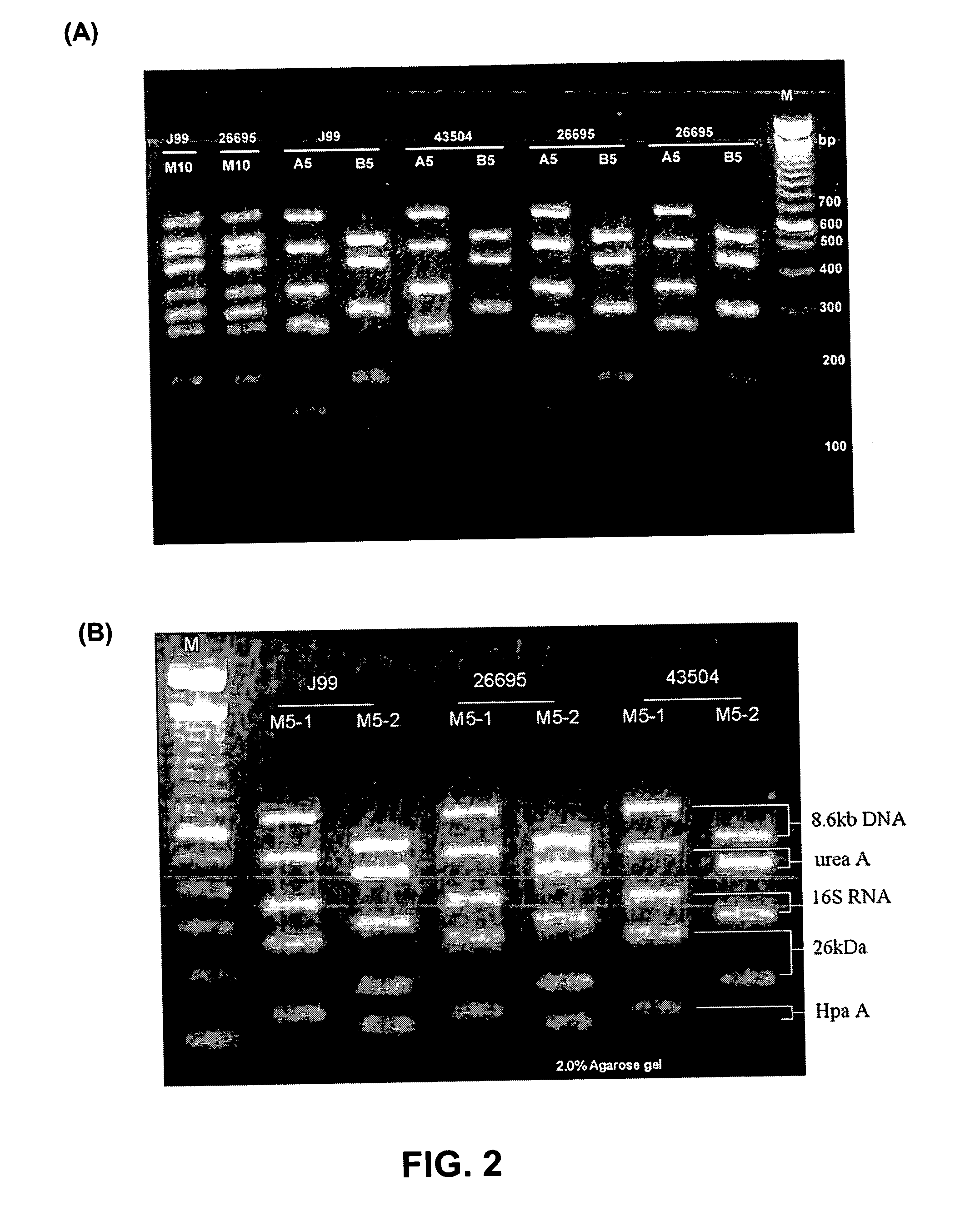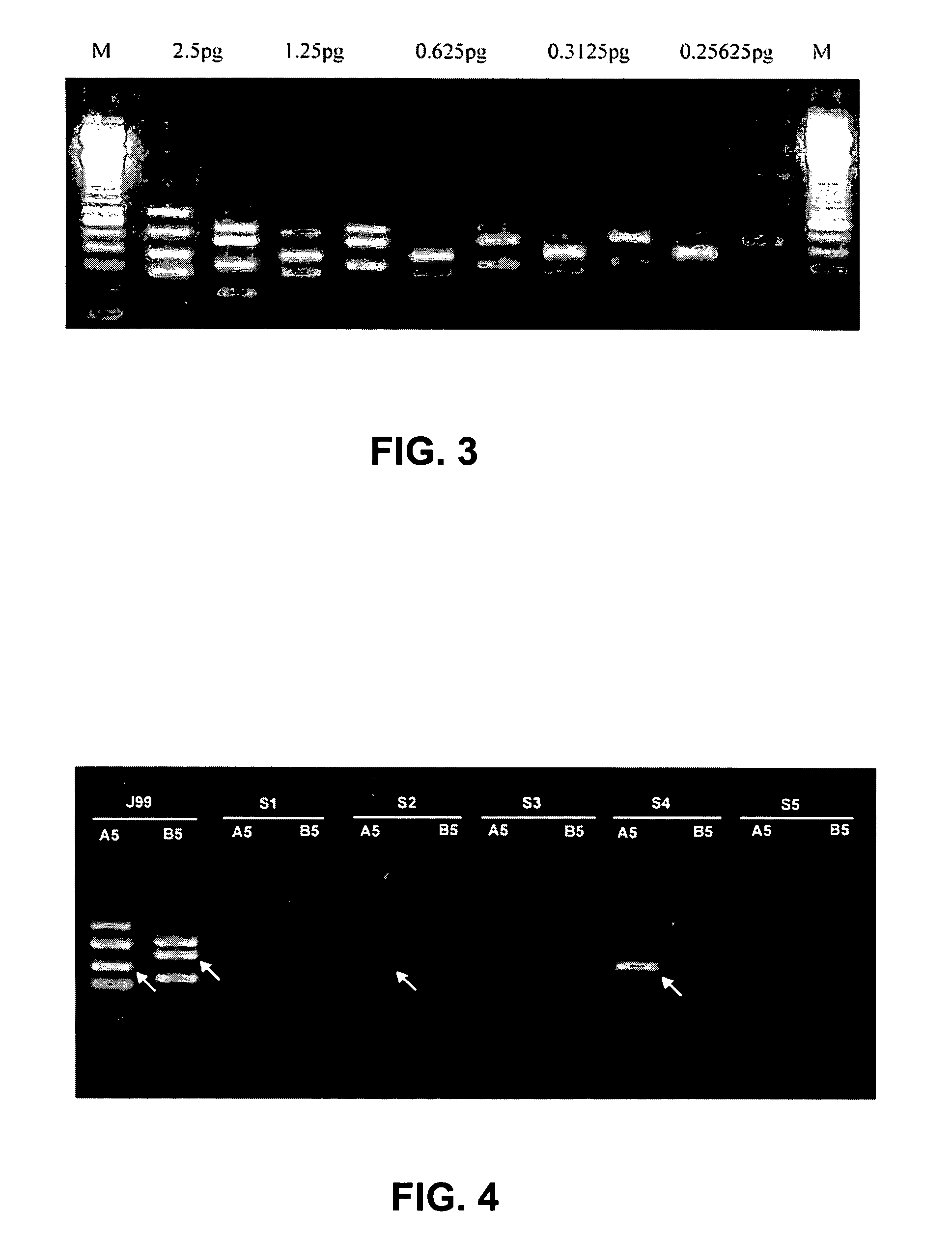Methods and compositions to detect bacteria using multiplex PCR
- Summary
- Abstract
- Description
- Claims
- Application Information
AI Technical Summary
Benefits of technology
Problems solved by technology
Method used
Image
Examples
example 1
Comparison of Multiplex PCR with CLOtest for Detection of H. pylori
[0093] Ninety patients with dyspepsia symptoms undergoing endoscopy in Evanston Northwestern Healthcare (Evanston, Ill.) were selected. To overcome the problem of patchy H. pylori distribution so that the organism is not captured in the tested tissue sample, the same gastric specimen was used for both the CLOtest and PCR assay. The CLOtest was performed first following standard protocols and the results were obtained from about 20 minutes to 24 hours. The specimens were collected from the CLOtest gel, DNA was isolated, and the one-step multiplex PCR was performed.
[0094] The multiplex PCR amplification was performed for about 36-40 cycles and the amplified PCR products were detected on an agarose gel electrophoresis system. Using the standard Helicobacter pylori DNA as a template, 10 expected DNA fragments were obtained after amplification with the PCR method disclosed herein. On a 2% agarose gel, the following DNA ...
example 2
Comparison of Multiplex PCR with Histology for Detection of H. pylori
[0096] Four to five gastric specimens were collected from 90 patients with dyspepsia symptoms undergoing endoscopy in Evanston Northwestern Healthcare. One specimen was sent to the clinical laboratory for the histology study performed by an expert clinical pathologist. The other two or three specimens were collected for DNA extraction and the one-step multiplex PCR was performed as described in Example 1. For the multiplex PCR analysis, a specimen was considered positive for H. pylori if 5 out of 10 DNA fragments or both DNA fragments from 2 out of the 5 loci were amplified.
[0097] As disclosed in Example 1, positive results were obtained in 68% (61 / 90) with multiplex PCR and 11% (10 / 90) with histology study (TABLE 1). The sensitivity and specificity was 16% and 100% for the histology method relative to multiplex PCR respectively (TABLE 1). The 10-primer pair-combination plus the internal control of each locus sho...
example 3
Food Products Tests for H. pylori
[0098] Eleven fresh raw chickens and 18 orders of ready-to-eat raw tuna meat were collected from local grocery and restaurants respectively. The samples were washed with enough volumes of phosphate buffered saline (PBS) and then the solution was concentrated to recover the bacteria. DNA was isolated by methods with some modifications and the disclosed novel one-step multiplex PCR detection system was used. For the multiplex PCR analysis, a specimen was considered positive for H. pylori if 5 out of 10 DNA fragments or both DNA fragments from 2 out of the 5 loci were amplified. H. pylori positive results were achieved in 36% (4 / 11) from fresh raw chickens and 44% (8 / 18) from ready-to-eat raw tuna meat by using the multiplex PCR detection system. Results indicated that the test samples obtained from local grocery and restaurants were contaminated with H. pylori. In spite of the difficulty in culturing H. pylori by currently available methods, this is e...
PUM
| Property | Measurement | Unit |
|---|---|---|
| Temperature | aaaaa | aaaaa |
| Fraction | aaaaa | aaaaa |
| Molar density | aaaaa | aaaaa |
Abstract
Description
Claims
Application Information
 Login to View More
Login to View More - R&D
- Intellectual Property
- Life Sciences
- Materials
- Tech Scout
- Unparalleled Data Quality
- Higher Quality Content
- 60% Fewer Hallucinations
Browse by: Latest US Patents, China's latest patents, Technical Efficacy Thesaurus, Application Domain, Technology Topic, Popular Technical Reports.
© 2025 PatSnap. All rights reserved.Legal|Privacy policy|Modern Slavery Act Transparency Statement|Sitemap|About US| Contact US: help@patsnap.com



